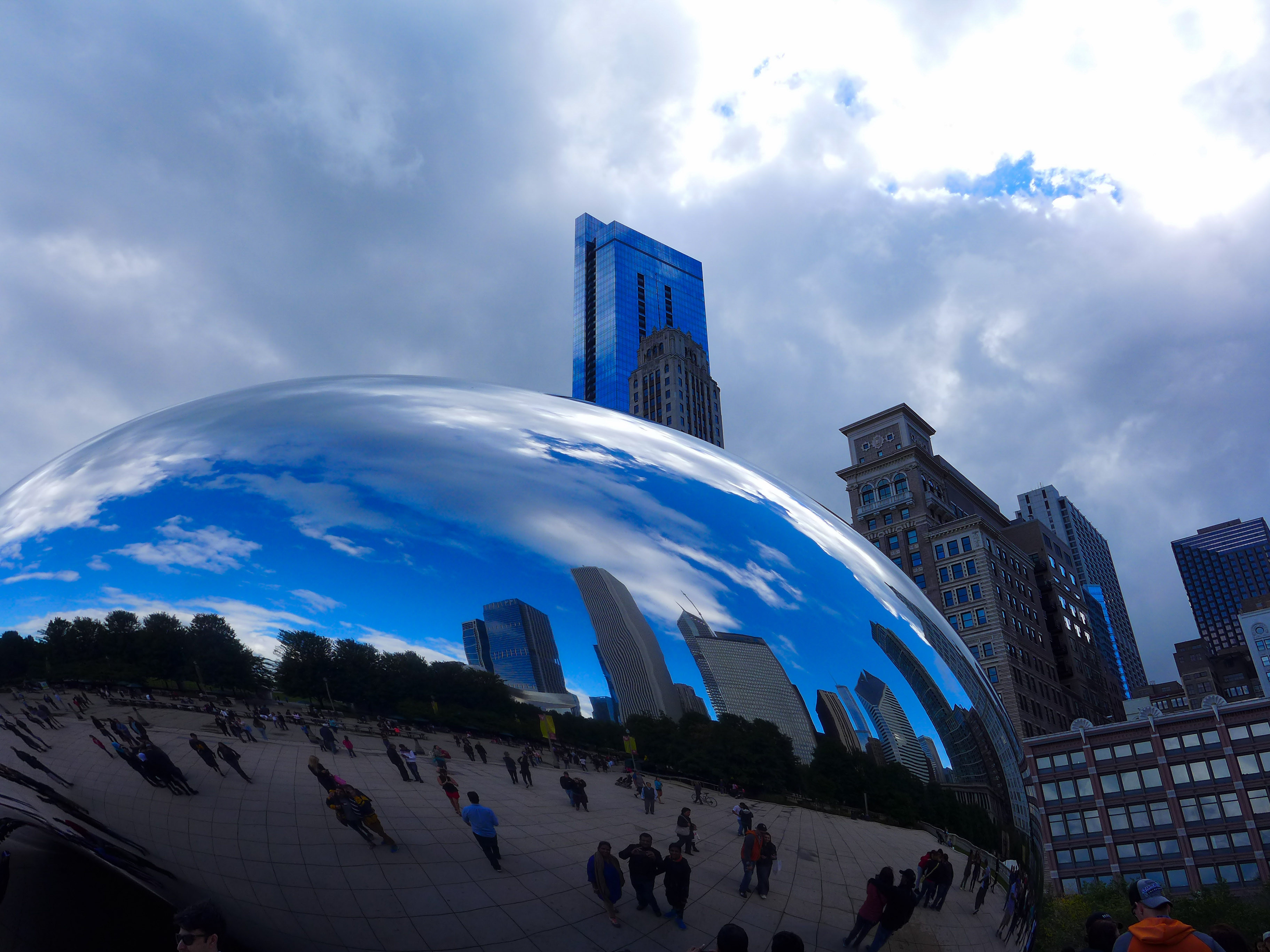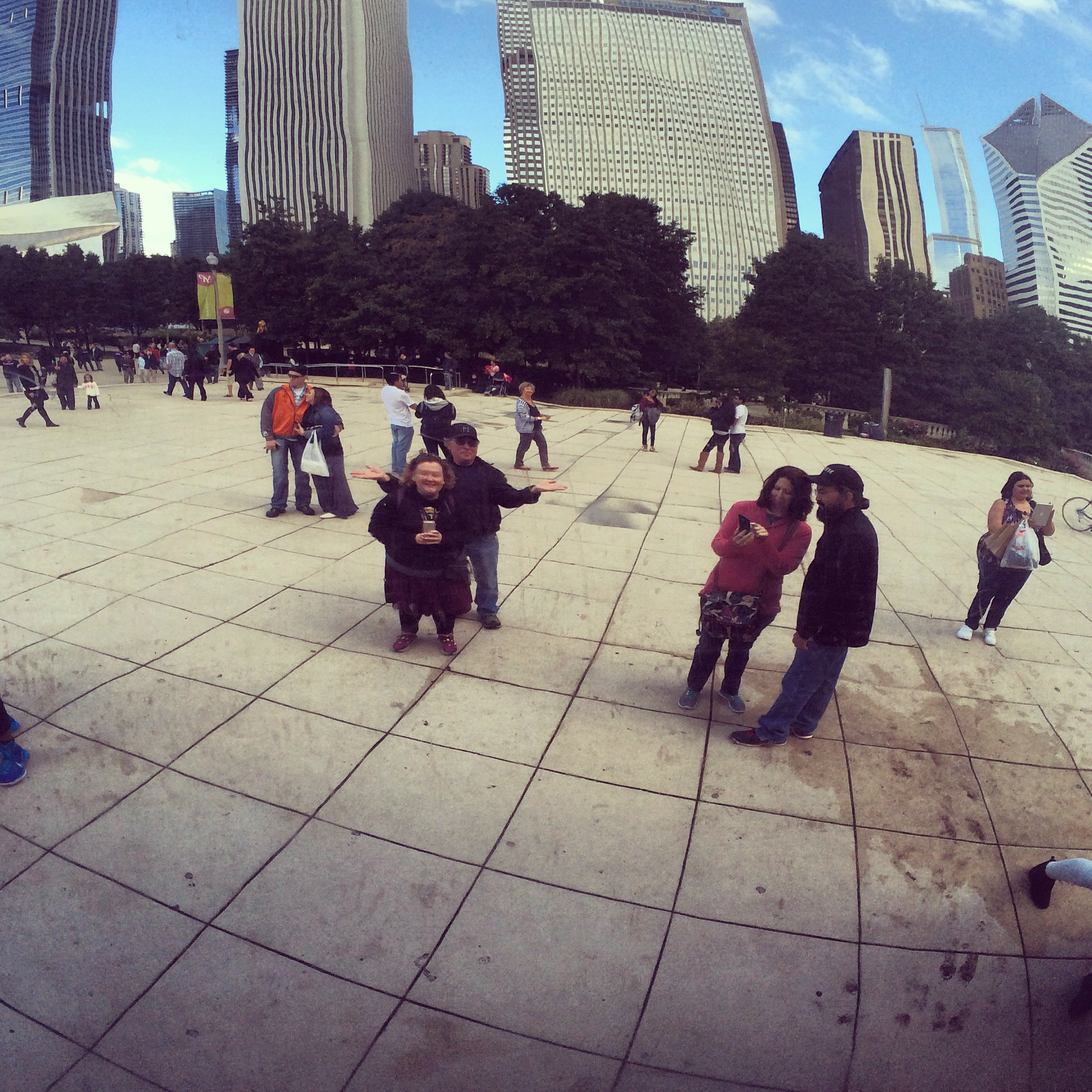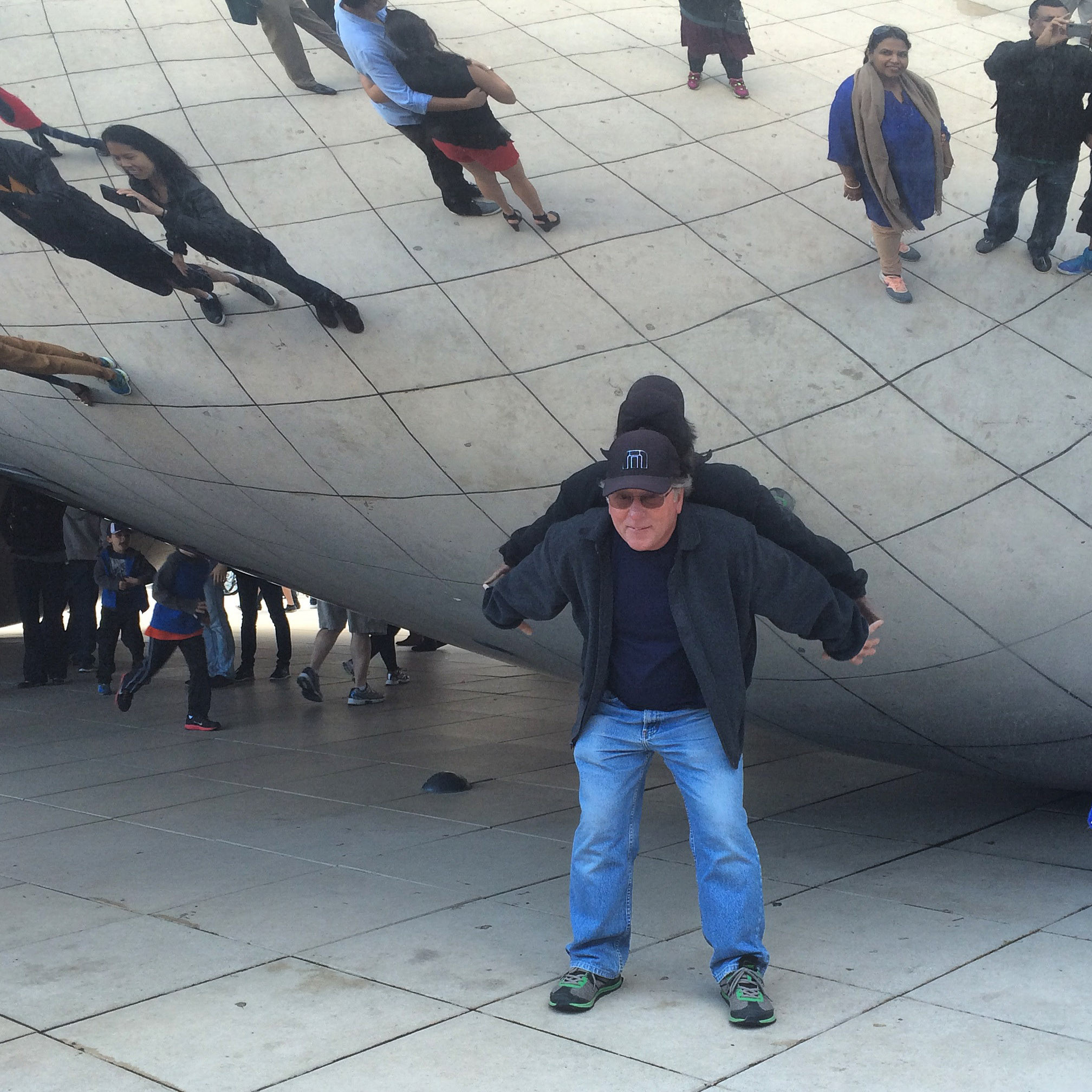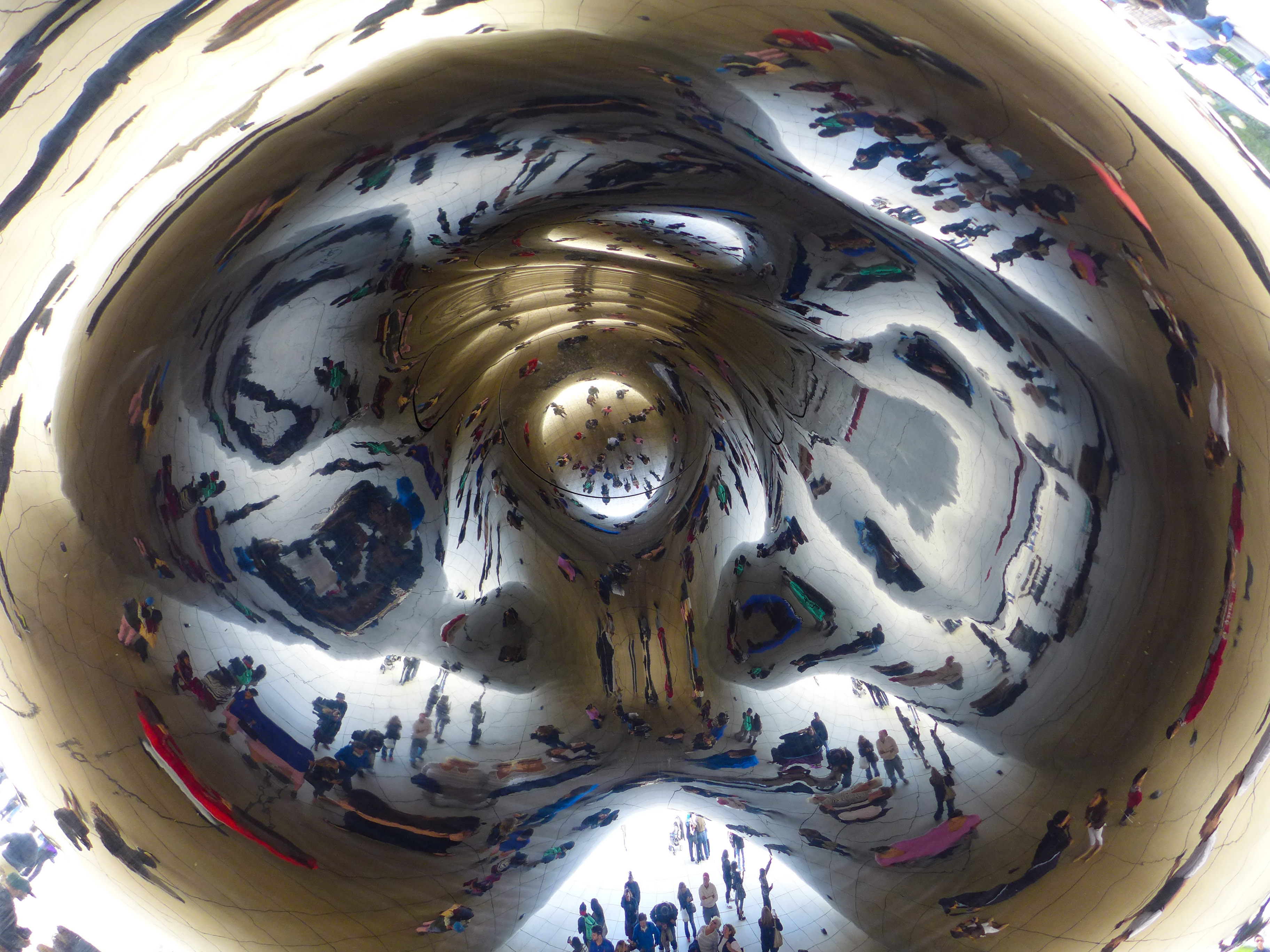The Bean, officially known as Cloud Gate, has significantly impacted Chicago tourism, drawing millions annually and becoming an iconic symbol of the city, and SIXT.VN is here to help you plan your visit to see it. This public art sculpture has not only boosted the city’s economy but also enhanced its cultural appeal, making Chicago a must-visit destination for art enthusiasts and tourists alike. Explore Chicago’s vibrant culture with ease by using SIXT.VN for convenient airport transfers, comfortable hotel bookings, and guided tours.
Contents
- 1. What is the Cloud Gate and Why is it Called “The Bean?”
- 1.1 Who Designed Cloud Gate?
- 1.2 Why is it Called “The Bean?”
- 2. How Has the Bean Become a Chicago Icon?
- 2.1 What is the Architectural Significance of the Bean?
- 2.2 How Does the Bean Reflect Chicago’s Identity?
- 3. How Has The Bean Impacted Chicago Tourism?
- 3.1 What is the Annual Tourist Footfall at the Bean?
- 3.2 How Does the Bean Contribute to Chicago’s Economy?
- 3.3 What are the Tourist Activities Around the Bean?
- 4. What is the Cultural Significance of the Bean?
- 4.1 How Does the Bean Influence Public Art in Chicago?
- 4.2 How Does the Bean Reflect Chicago’s Artistic Community?
- 4.3 How Has the Bean Fostered Community Engagement?
- 5. What are the Criticisms and Controversies Surrounding the Bean?
- 5.1 What are the Common Criticisms of the Bean’s Design?
- 5.2 How Has Commercialization Affected the Bean’s Image?
- 5.3 What are the Copyright Issues Related to the Bean?
- 6. How Can Tourists Best Experience The Bean?
- 6.1 What is the Best Time to Visit the Bean?
- 6.2 What are the Nearby Attractions and Activities?
- 6.3 What are the Best Photo Opportunities at the Bean?
- 7. How Does the Bean Compare to Other Public Art Installations?
- 7.1 What Makes the Bean Unique?
- 7.2 How Does the Bean Represent Modern Art?
- 7.3 What Other Famous Public Art Installations Exist?
- 8. What are the Future Plans for the Bean and Millennium Park?
- 8.1 How Will the Bean Be Maintained?
- 8.2 What Events are Planned for Millennium Park?
- 8.3 How Will Millennium Park Evolve in the Future?
- 9. What are Some Interesting Facts About the Bean?
- 9.1 What Materials Were Used to Construct the Bean?
- 9.2 How Long Did it Take to Build the Bean?
- 9.3 How Much Did it Cost to Build the Bean?
- 10. What Travel Services Does SIXT.VN Provide for Visiting Chicago?
- 10.1 Airport Transfer Services
- 10.2 Hotel Booking Services
- 10.3 Guided Tours of Chicago
- FAQ about The Bean in Chicago
1. What is the Cloud Gate and Why is it Called “The Bean?”
The Cloud Gate is a public sculpture located in Millennium Park in Chicago, Illinois, designed by British artist Sir Anish Kapoor. Affectionately nicknamed “The Bean” because of its unique bean-like shape, this iconic structure has become one of Chicago’s most beloved landmarks. Its smooth, reflective surface mirrors the city’s skyline and the surrounding park, creating an interactive and visually stunning experience for visitors. Cloud Gate is one of the world’s largest permanent outdoor art installations.
The sculpture is made up of 168 stainless steel plates welded together, with its highly polished exterior reflecting and distorting the city’s skyline. This distortion creates a fun and engaging experience as visitors interact with the sculpture, making it a popular spot for photographs and selfies. The seamless surface was achieved through meticulous polishing, making it appear as one continuous form.
1.1 Who Designed Cloud Gate?
Cloud Gate was designed by Sir Anish Kapoor, a British-Indian sculptor renowned for his large-scale public installations and abstract forms. Kapoor’s work often explores themes of space, light, and perception, inviting viewers to engage with his art on a visceral and emotional level. According to the Chicago Architecture Center, Kapoor was born in Bombay and educated in Britain.
1.2 Why is it Called “The Bean?”
The nickname “The Bean” was given to the sculpture by locals and tourists alike due to its distinctive shape, which resembles a giant bean. While its official name is Cloud Gate, the moniker “The Bean” has stuck, becoming a popular and endearing way to refer to the artwork. The informal name adds to its approachable and playful nature, making it more accessible to a wider audience.
2. How Has the Bean Become a Chicago Icon?
The Bean’s rise to iconic status can be attributed to several factors, including its striking design, its interactive nature, and its prominent location in Millennium Park. Since its unveiling in 2004, the sculpture has captured the imagination of locals and tourists alike, quickly becoming a symbol of Chicago’s vibrant arts scene and urban identity. According to Choose Chicago, the city’s official tourism website, Millennium Park attracts millions of visitors each year, with Cloud Gate being a major draw.
2.1 What is the Architectural Significance of the Bean?
The architectural significance of the Bean lies in its innovative design and its ability to transform the surrounding environment. Its seamless, reflective surface creates a dynamic interplay between the sculpture, the city skyline, and the people who interact with it. The Bean’s form challenges traditional notions of sculpture, inviting viewers to become active participants in the artistic experience. It embodies a blend of art and architecture that enhances the urban landscape.
2.2 How Does the Bean Reflect Chicago’s Identity?
The Bean reflects Chicago’s identity as a modern, innovative, and culturally rich city. Its reflective surface captures the city’s iconic skyline, symbolizing Chicago’s architectural prowess and its position as a global hub. The Bean’s interactive nature mirrors Chicago’s welcoming spirit, inviting people from all walks of life to come together and experience art in a public space. It represents Chicago’s commitment to art, culture, and community engagement.
3. How Has The Bean Impacted Chicago Tourism?
The Bean has had a profound impact on Chicago tourism, drawing millions of visitors to the city each year and generating significant economic benefits. Its unique design and interactive nature make it a must-see attraction for tourists of all ages, contributing to Chicago’s reputation as a top tourist destination. SIXT.VN offers convenient services to ensure your visit to Chicago and the Bean is seamless, from airport transfers to booking hotels near Millennium Park.
 Cloud Gate in Millennium Park reflecting the Chicago skyline
Cloud Gate in Millennium Park reflecting the Chicago skyline
3.1 What is the Annual Tourist Footfall at the Bean?
The Bean attracts millions of visitors each year, making it one of Chicago’s most popular tourist attractions. According to the Chicago Department of Cultural Affairs and Special Events, Millennium Park, where the Bean is located, welcomes over 25 million visitors annually. A significant portion of these visitors come specifically to see and interact with the Cloud Gate sculpture. The consistent influx of tourists highlights the Bean’s enduring appeal and its impact on Chicago’s tourism industry.
3.2 How Does the Bean Contribute to Chicago’s Economy?
The Bean’s popularity generates significant economic benefits for Chicago, boosting revenue for local businesses and supporting jobs in the tourism sector. Tourists who visit the Bean often spend money on accommodations, dining, shopping, and entertainment, contributing to the city’s overall economic growth. The Bean also enhances Chicago’s image as a desirable place to live, work, and visit, attracting investment and talent to the city.
3.3 What are the Tourist Activities Around the Bean?
Around the Bean, tourists can engage in a variety of activities, including taking photographs, admiring the city skyline, and exploring the surrounding Millennium Park. The park offers gardens, performance spaces, and other public art installations, providing a rich cultural experience for visitors. Tourists can also take guided tours of the park, attend events and festivals, or simply relax and enjoy the vibrant atmosphere. With SIXT.VN, you can easily book tickets for tours and events, making your visit even more enjoyable.
4. What is the Cultural Significance of the Bean?
Beyond its economic impact, the Bean holds significant cultural value for Chicago, serving as a symbol of the city’s artistic innovation and community engagement. Its presence in Millennium Park has helped to revitalize the downtown area, creating a vibrant public space where people from all walks of life can come together and experience art. The Bean has become an integral part of Chicago’s cultural identity, inspiring creativity and fostering a sense of civic pride.
4.1 How Does the Bean Influence Public Art in Chicago?
The Bean has influenced public art in Chicago by demonstrating the power of art to transform public spaces and engage communities. Its success has inspired other artists and city planners to create innovative public art installations that enhance the urban environment and enrich the lives of residents and visitors. The Bean has set a high standard for public art in Chicago, encouraging creativity and innovation in the field.
4.2 How Does the Bean Reflect Chicago’s Artistic Community?
The Bean reflects Chicago’s artistic community by embodying the city’s spirit of innovation, creativity, and collaboration. Its design reflects the city’s architectural heritage, while its interactive nature mirrors the community’s welcoming and inclusive ethos. The Bean has become a symbol of Chicago’s commitment to art and culture, showcasing the city’s vibrant artistic scene to the world.
4.3 How Has the Bean Fostered Community Engagement?
The Bean has fostered community engagement by providing a public space where people from all backgrounds can come together and interact with art. Its accessible location and interactive nature make it a popular gathering spot for locals and tourists alike, fostering a sense of community and belonging. The Bean has become a symbol of Chicago’s commitment to inclusivity and public engagement.
5. What are the Criticisms and Controversies Surrounding the Bean?
Despite its popularity, the Bean has faced criticisms and controversies over the years, ranging from concerns about its cost and construction to debates about its artistic merit. Some critics have questioned whether the Bean is a worthy addition to Chicago’s public art collection, while others have raised concerns about the commercialization of the artwork. Despite these criticisms, the Bean remains a beloved landmark for many, its enduring appeal testament to its cultural significance.
5.1 What are the Common Criticisms of the Bean’s Design?
Some common criticisms of the Bean’s design include concerns about its aesthetic appeal and its suitability for the surrounding environment. Some critics argue that the Bean’s reflective surface is distracting or that its shape is uninspired. Others question whether the Bean’s design adequately reflects Chicago’s architectural heritage or its cultural identity. Despite these criticisms, the Bean’s design continues to captivate visitors and inspire debate.
 Tourists interacting with the reflective surface of Cloud Gate
Tourists interacting with the reflective surface of Cloud Gate
5.2 How Has Commercialization Affected the Bean’s Image?
Commercialization has affected the Bean’s image by turning it into a popular backdrop for advertisements, merchandise, and other commercial ventures. Some critics argue that this commercialization has detracted from the Bean’s artistic integrity, turning it into a mere commodity rather than a work of art. Others maintain that the Bean’s popularity has helped to raise awareness of public art and promote Chicago as a tourist destination.
5.3 What are the Copyright Issues Related to the Bean?
Copyright issues related to the Bean have arisen due to its status as a copyrighted artwork. The artist, Anish Kapoor, retains the copyright to the Bean’s design, which means that commercial uses of images of the Bean may require permission from the artist or his representatives. This has led to debates about the extent to which the public can freely photograph and share images of the Bean without infringing on the artist’s copyright.
6. How Can Tourists Best Experience The Bean?
To best experience the Bean, tourists should plan their visit carefully, taking into account factors such as the time of day, the weather conditions, and the crowds. Arriving early in the morning or later in the evening can help to avoid the crowds and provide a more intimate viewing experience. Tourists should also take the time to explore the surrounding Millennium Park, which offers a variety of attractions and activities. With SIXT.VN, you can book transportation, accommodations, and tours to enhance your visit.
6.1 What is the Best Time to Visit the Bean?
The best time to visit the Bean is during the early morning or late evening hours, when the crowds are smaller and the lighting is optimal for photography. Visiting during the weekdays rather than weekends can also help to avoid the crowds. Additionally, visiting during the spring or fall months can provide more comfortable weather conditions for exploring the park.
6.2 What are the Nearby Attractions and Activities?
Nearby attractions and activities include the Crown Fountain, the Lurie Garden, the Art Institute of Chicago, and the Chicago Cultural Center. Millennium Park also hosts a variety of events and festivals throughout the year, offering entertainment and cultural experiences for visitors. Tourists can also take boat tours of the Chicago River, visit nearby museums and theaters, or explore the city’s vibrant neighborhoods.
 Visitors enjoying the reflections at Cloud Gate
Visitors enjoying the reflections at Cloud Gate
6.3 What are the Best Photo Opportunities at the Bean?
The best photo opportunities at the Bean include capturing the reflections of the city skyline, taking close-up shots of the Bean’s surface, and photographing people interacting with the sculpture. Experimenting with different angles and perspectives can help to create unique and visually stunning images. Additionally, visiting during sunrise or sunset can provide dramatic lighting for photography.
7. How Does the Bean Compare to Other Public Art Installations?
The Bean stands out among other public art installations due to its unique design, its interactive nature, and its ability to transform the surrounding environment. Unlike traditional sculptures that are meant to be viewed from a distance, the Bean invites viewers to engage with it on a physical and emotional level. Its reflective surface creates a dynamic interplay between the sculpture, the city skyline, and the people who interact with it, making it a truly unique and memorable work of art.
7.1 What Makes the Bean Unique?
The Bean’s uniqueness lies in its seamless design, its reflective surface, and its interactive nature. Its seamless design creates a sense of unity and wholeness, while its reflective surface captures the beauty and dynamism of the surrounding environment. Its interactive nature invites viewers to become active participants in the artistic experience, fostering a sense of community and engagement.
7.2 How Does the Bean Represent Modern Art?
The Bean represents modern art by challenging traditional notions of sculpture and inviting viewers to engage with art in new and innovative ways. Its abstract form and its interactive nature reflect the values of modern art, which emphasizes experimentation, creativity, and public engagement. The Bean has become a symbol of modern art in Chicago, showcasing the city’s commitment to innovation and artistic expression.
7.3 What Other Famous Public Art Installations Exist?
Other famous public art installations include the Statue of Liberty in New York City, the Eiffel Tower in Paris, and the Sydney Opera House in Sydney. These landmarks, like the Bean, have become iconic symbols of their respective cities, attracting millions of visitors each year and generating significant economic and cultural benefits. Public art installations play a vital role in shaping the urban landscape and enriching the lives of residents and visitors.
8. What are the Future Plans for the Bean and Millennium Park?
Future plans for the Bean and Millennium Park include ongoing maintenance and preservation efforts to ensure the sculpture’s long-term viability. The city of Chicago also plans to continue hosting events and festivals in Millennium Park, further enhancing its appeal as a public gathering space. Additionally, there may be future plans to add new public art installations to the park, continuing to enrich Chicago’s cultural landscape.
8.1 How Will the Bean Be Maintained?
The Bean will be maintained through regular cleaning and inspection to ensure that its surface remains clean and reflective. The city of Chicago also conducts periodic repairs and maintenance to address any damage or wear and tear. These efforts are essential to preserving the Bean’s beauty and integrity for future generations to enjoy.
 People taking photos in front of the Bean
People taking photos in front of the Bean
8.2 What Events are Planned for Millennium Park?
Events planned for Millennium Park include concerts, festivals, art exhibitions, and community gatherings. These events attract visitors from all over the world, providing entertainment and cultural experiences for people of all ages. Millennium Park has become a vibrant hub of activity in downtown Chicago, offering a diverse range of programming throughout the year.
8.3 How Will Millennium Park Evolve in the Future?
Millennium Park will continue to evolve in the future as the city of Chicago seeks to enhance its appeal as a public space. Future plans may include adding new public art installations, improving park amenities, and expanding programming to attract a wider audience. Millennium Park’s evolution will ensure that it remains a vibrant and dynamic destination for residents and visitors alike.
9. What are Some Interesting Facts About the Bean?
Some interesting facts about the Bean include that it is made of 168 stainless steel plates, weighs 110 tons, and measures 66 feet long by 33 feet high. The Bean’s reflective surface is inspired by liquid mercury, and its seamless design was achieved through meticulous polishing. The Bean has become one of Chicago’s most popular landmarks, attracting millions of visitors each year and generating significant economic benefits for the city.
9.1 What Materials Were Used to Construct the Bean?
The Bean was constructed using 168 stainless steel plates, which were welded together to create a seamless surface. The sculpture’s reflective surface is achieved through meticulous polishing, making it appear as one continuous form. Stainless steel was chosen for its durability and its ability to withstand the elements, ensuring the Bean’s long-term viability.
9.2 How Long Did it Take to Build the Bean?
It took approximately two years to build the Bean, from its initial design to its final installation in Millennium Park. The construction process involved complex engineering and fabrication techniques to ensure that the sculpture met the artist’s vision and the city’s safety standards. The Bean’s construction was a collaborative effort involving artists, engineers, and construction workers, showcasing the city’s commitment to innovation and artistic expression.
9.3 How Much Did it Cost to Build the Bean?
The Bean cost approximately $23 million to build, making it one of the most expensive public art installations in the world. The cost included the design, fabrication, transportation, and installation of the sculpture, as well as ongoing maintenance and preservation efforts. Despite its high cost, the Bean has proven to be a valuable investment for the city of Chicago, generating significant economic and cultural benefits.
10. What Travel Services Does SIXT.VN Provide for Visiting Chicago?
SIXT.VN provides a range of travel services for visitors to Chicago, including airport transfers, hotel bookings, and guided tours. Our airport transfer service ensures a seamless and stress-free arrival and departure, while our hotel booking service offers a variety of accommodations to suit every budget and preference. Our guided tours provide a comprehensive overview of Chicago’s top attractions, including the Bean and Millennium Park.
10.1 Airport Transfer Services
SIXT.VN offers reliable and comfortable airport transfer services from both O’Hare International Airport (ORD) and Midway International Airport (MDW) to hotels and other destinations in Chicago. Our professional drivers will meet you at the airport and transport you to your destination in style, ensuring a hassle-free start to your visit.
10.2 Hotel Booking Services
SIXT.VN provides a wide selection of hotels in Chicago, ranging from budget-friendly options to luxury accommodations. Our hotel booking service allows you to compare prices, amenities, and locations, making it easy to find the perfect hotel for your needs. We also offer exclusive deals and discounts to help you save money on your accommodations.
10.3 Guided Tours of Chicago
SIXT.VN offers guided tours of Chicago that showcase the city’s top attractions, including the Bean, Millennium Park, the Art Institute of Chicago, and more. Our knowledgeable guides will provide you with insights into Chicago’s history, culture, and architecture, making your visit more enriching and memorable. Whether you’re interested in a walking tour, a bus tour, or a private tour, we have options to suit every interest and budget.
Visiting Chicago and experiencing the iconic Bean is now easier than ever with SIXT.VN. From convenient airport transfers and comfortable hotel bookings to guided tours that bring the city to life, SIXT.VN ensures a seamless and unforgettable travel experience.
Ready to explore Chicago? Contact SIXT.VN today to plan your perfect trip!
Address: 260 Cau Giay, Hanoi, Vietnam
Hotline/Whatsapp: +84 986 244 358
Website: SIXT.VN
FAQ about The Bean in Chicago
-
What is the official name of The Bean?
The official name of The Bean is Cloud Gate.
-
Who designed Cloud Gate?
Cloud Gate was designed by British artist Sir Anish Kapoor.
-
Why is it called “The Bean?”
It’s nicknamed “The Bean” due to its bean-like shape.
-
Where is The Bean located?
The Bean is located in Millennium Park in Chicago, Illinois.
-
What is The Bean made of?
The Bean is made of 168 stainless steel plates welded together.
-
How much did it cost to build The Bean?
The Bean cost approximately $23 million to build.
-
How much does The Bean weigh?
The Bean weighs approximately 110 tons.
-
What is the best time to visit The Bean?
The best time to visit is early morning or late evening to avoid crowds.
-
Can you touch The Bean?
Yes, visitors are allowed to touch and interact with The Bean.
-
Are there any copyright restrictions on photographing The Bean?
Yes, commercial use of images of The Bean may require permission from the artist.






